Managed Aquifer Recharge as a Strategic Storage and Urban Water Management Tool in Darwin, Northern Territory, Australia
Abstract
:1. Introduction
- Can MAR be used to reduce the groundwater stress (reduce the decline in groundwater levels during the dry season) in the Darwin rural area?
- Which MAR type is most effective (i.e., infiltration or injection)?
- Is there potential for well injection in the confined part of the aquifer for a strategic urban storage during the wet season?
2. Methodology
2.1. Koolpinyah Groundwater System Model
- No-flow boundaries around the western and southern portions of the model domain and at the bottom of layer 3. No-flow boundaries to the south-west represent the presence of low permeability basement rocks that would impede radial flow and increase mounding. It is acknowledged that the proximity of the area of interest (stressed areas) to the no-flow boundary may impact on simulation results.
- Constant head (Dirichlet) boundary conditions representing spring discharge from the dolostone.
- Seepage surface boundary conditions at the ground surface.
- Transfer (Cauchy) boundary conditions representing the fluxes at the coast and Adelaide River.
- Well boundary conditions to represent groundwater withdrawal.
2.2. Modelling Scenarios for Peri-Urban Groundwater Augmentation and a Strategic Storage
3. Results and Discussion
4. Conclusions
Author Contributions
Funding
Acknowledgments
Conflicts of Interest
References
- Power and Water Corporation. Darwin Region Water Supply Strategy; Power and Water Corporation: Darwin, Australia, 2013. [Google Scholar]
- CloudGMS. Koolpinyah Groundwater System Groundwater Flow Model Update 1.0.; Prepared for DLRM; CloudGMS: Adelaide, Australia, 2017. [Google Scholar]
- Fell-Smith, S.A.; Sumner, J. Technical Report—Koolpinyah Dolomite Aquifer Characteristics Project; Department of Land Resource Management. Water Resources Branch: Darwin, Australia, 2011. [Google Scholar]
- Cresswell, R.; Harrington, G.; Hodgen, M.; Li, L.; Petheram, C.; Buettikofer, H.; Davies, P. Water Resource in Northern Australia; CSIRO: Canberra, Australia, 2009. [Google Scholar]
- Vanderzalm, J.; Page, D.; Gonzalez, D.; Barry, K.; Dillon, P.; Taylor, A.; Dawes, W.; Cui, T.; Knapton, A. Assessment of Managed Aquifer Recharge (MAR) Opportunities in the Fitzroy, Darwin and Mitchell Catchments; A Technical Report to the Australian Government from the CSIRO Northern Australia Water Resource Assessment, Part of the National Water Infrastructure Development Fund: Water Resource Assessments; CSIRO: Canberra, Australia, 2018. [Google Scholar]
- NRMMC-EPHC-NHMRC. Australian Guidelines for Water Recycling: Managed Aquifer Recharge; National Water Quality Management Strategy Document No. 24; Natural Resource Management Ministerial Council, Environmental Protection and Heritage Council, National Health and Medical Research Council: Canberra, Australia, 2009. [Google Scholar]
- Barnett, B.; Townley, L.R.; Post, V.; Evans, R.E.; Hunt, R.J.; Peeters, L.; Richardson, S.; Werner, A.D.; Knapton, A.; Boronkay, A. Australian Groundwater Modelling Guidelines; National Water Commission: Canberra, Australia, 2012. [Google Scholar]
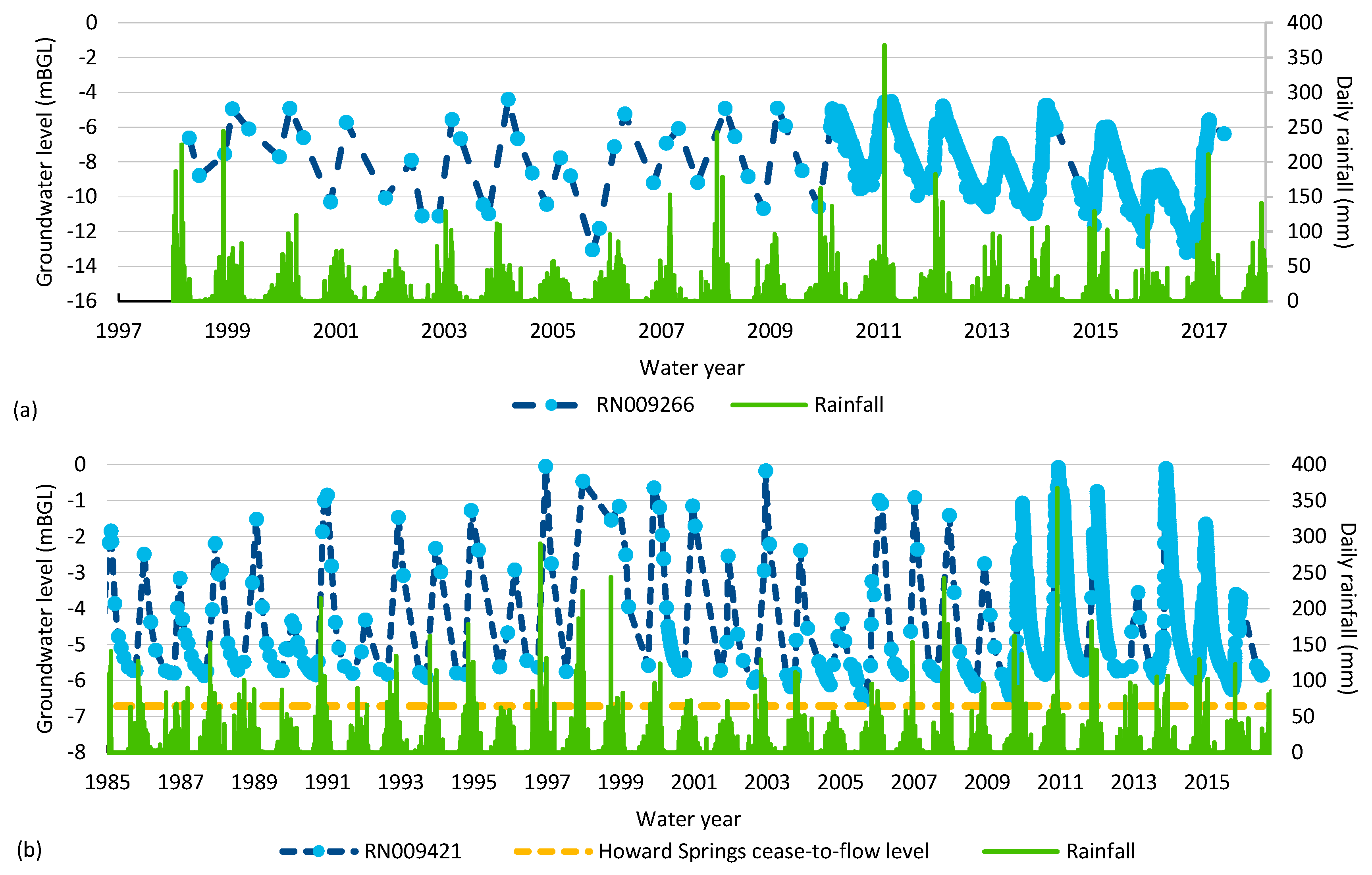
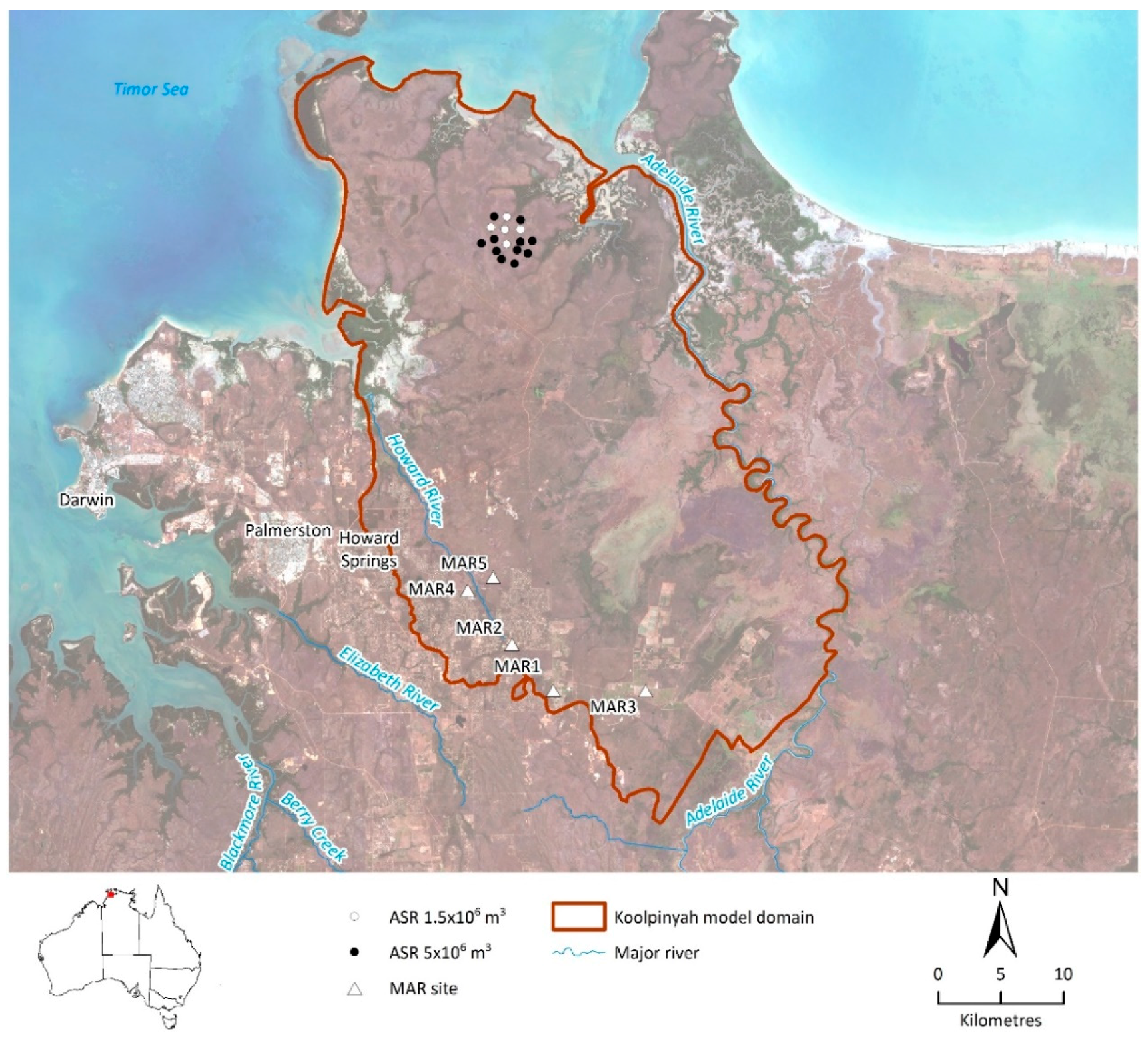
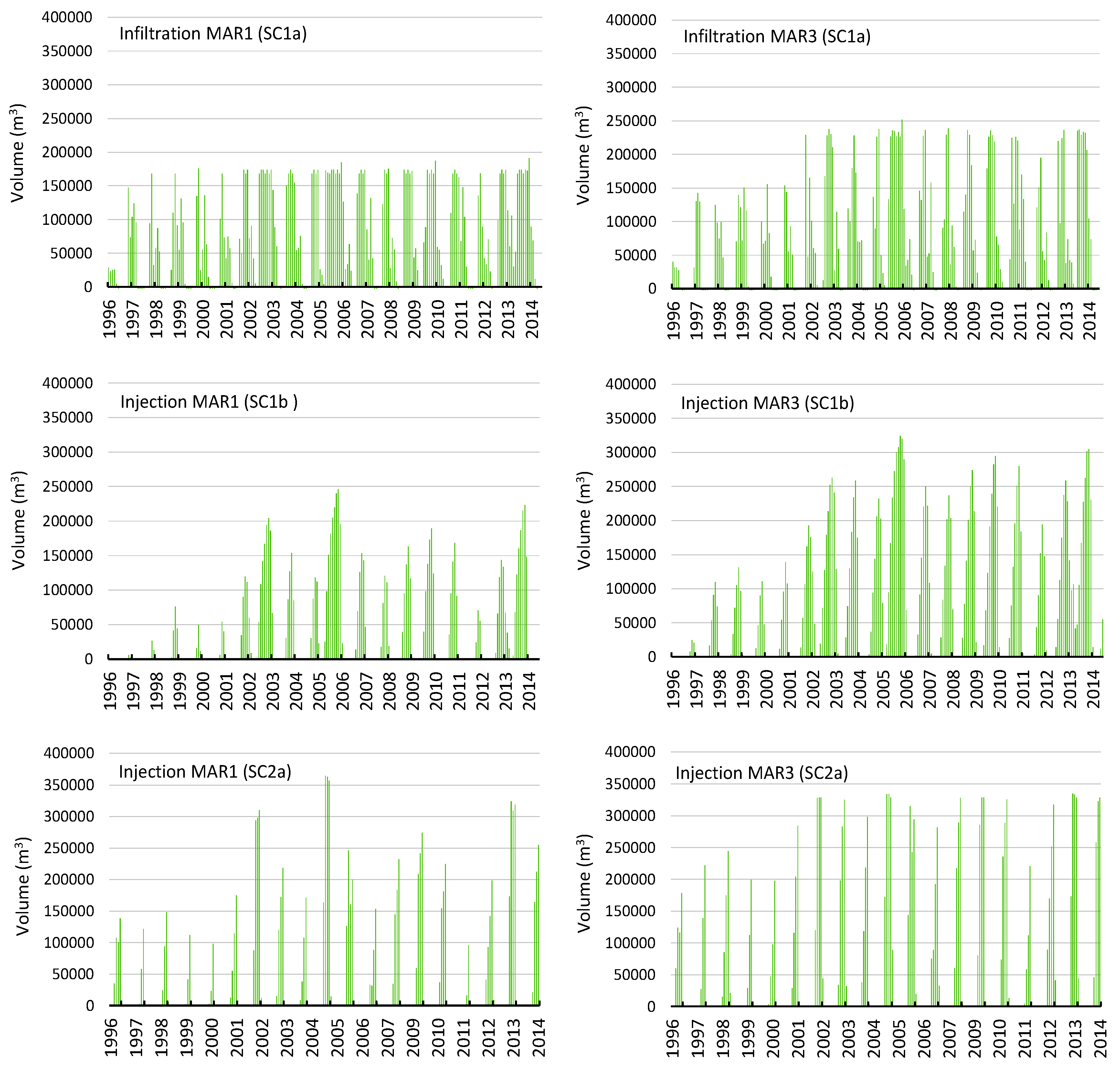
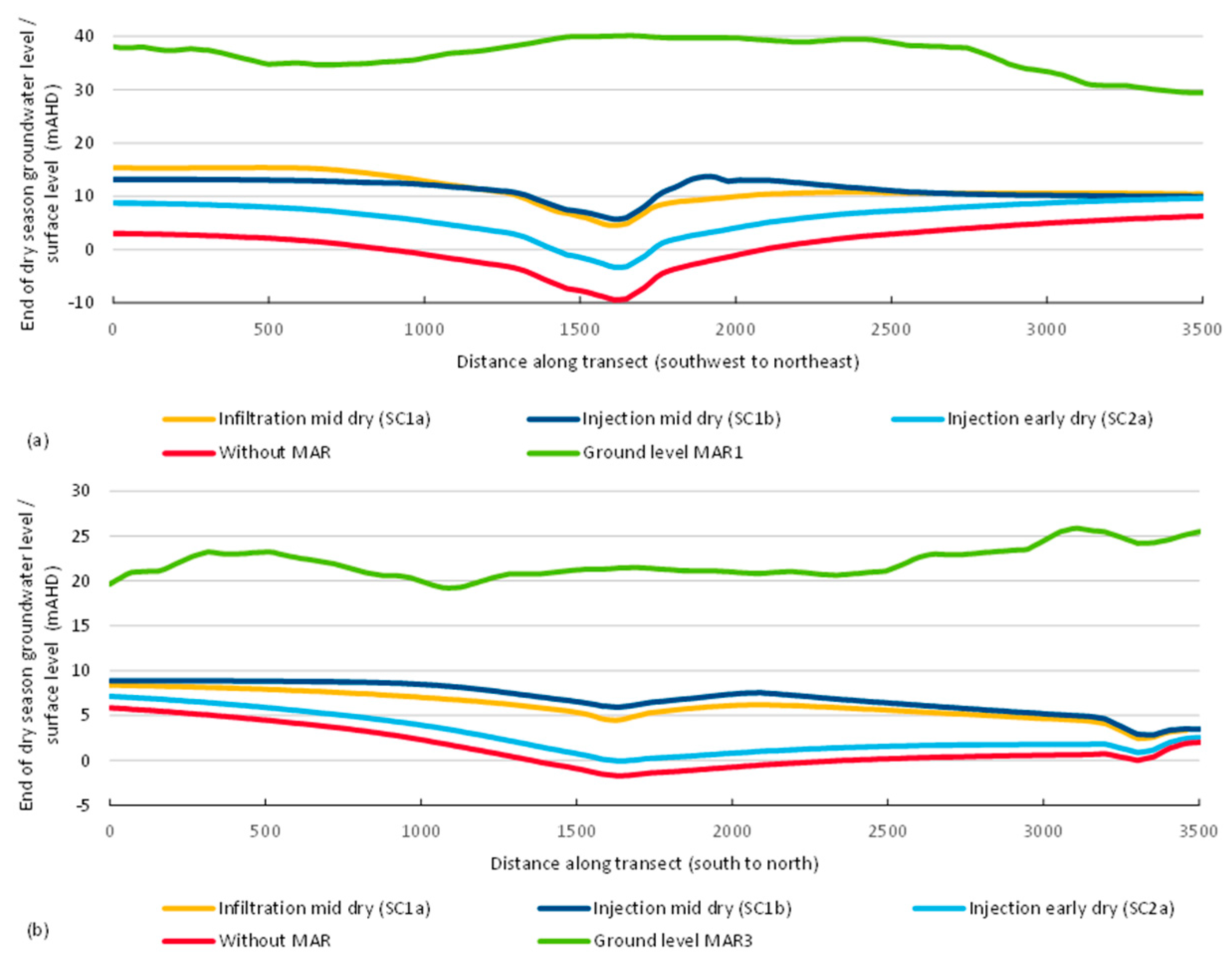
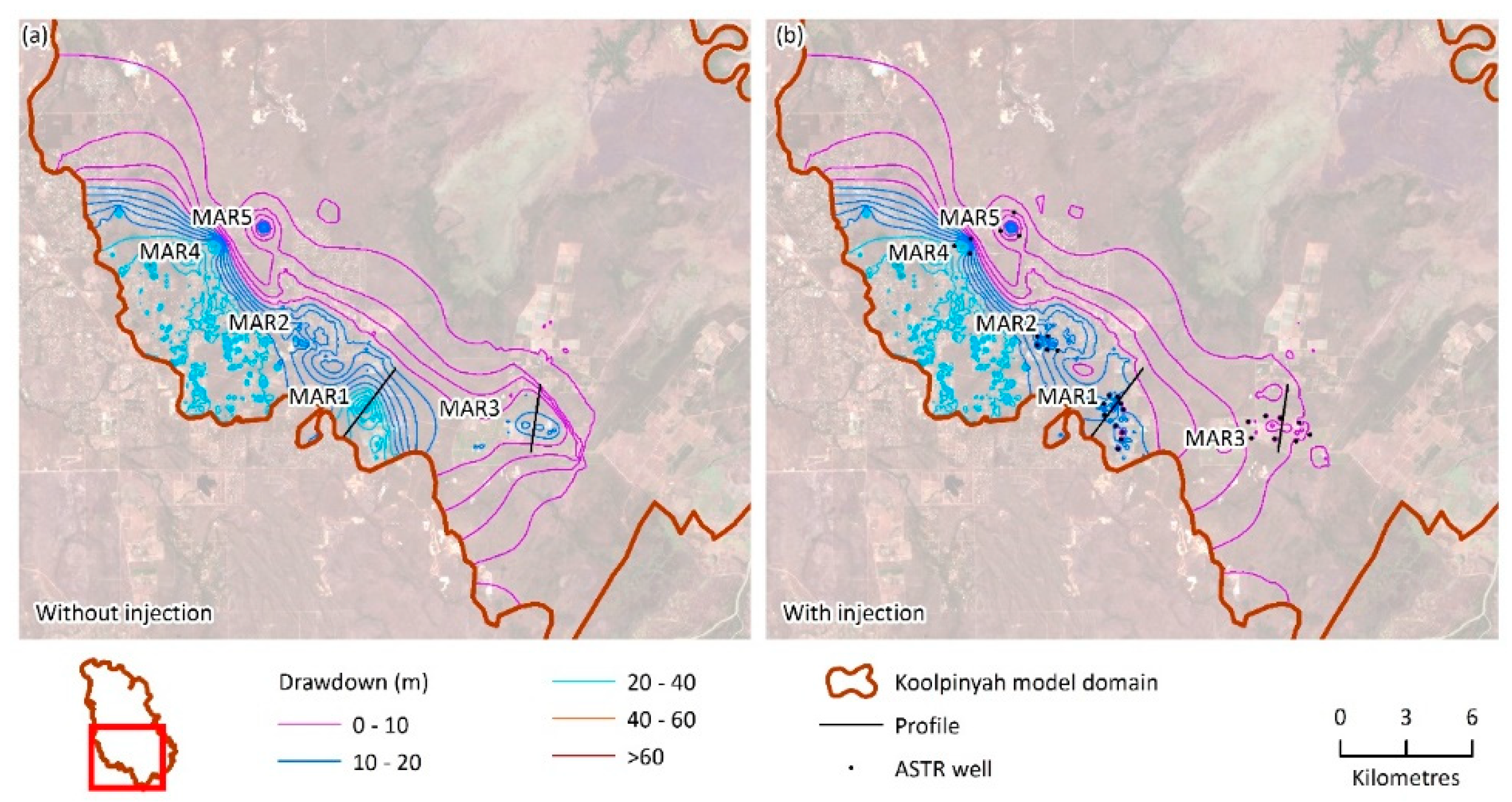
| Modelling Scenario | Description | Summary of Key Results |
|---|---|---|
| Base Case | Base case without MAR, simulated 1996–2014 | |
| Groundwater contours on 30 November 2009 (end of dry season) used for comparison to MAR scenarios | ||
| Base case groundwater levels on 30 November 2009 were used to set trigger values for MAR scenarios | ||
| MAR scenarios, detailed below: | MAR scenarios, simulated 1996–2014 | |
| Groundwater contours 30 November 2009 (end of dry season) compared to the base case | ||
| SC1a infiltration mid-dry season | Infiltration basins in five stressed locations, infiltration rate of 0.015 m/d, recharge targets layer 1 in the model, recharge triggered by water level (MAR1, 2, 4 and 5~18 mAHD; MAR3~10 mAHD) | Infiltration rate limited by storage capacity of the aquifer in locations tested |
| Model discretization too coarse to represent the cone of depression and limits the trigger to recharge in MAR2, 4 & 5 | ||
| Evaluation focuses on MAR1 & 3, where recharge was triggered | ||
| SC1b injection mid-dry season | ASTR wells in five stressed locations, injection rate of 1370 m3/d, recharge targets layer 3 in the model, recharge triggered by water level (MAR1, 2, 4 & 5~18 mAHD; MAR3~10 mAHD) | Recharge triggered mainly between August and December |
| Model discretization too coarse to represent the cone of depression and limits the trigger to recharge in MAR2, 4 & 5 | ||
| Evaluation focuses on MAR1 & 3, where recharge was triggered | ||
| SC1c injection wet season | ASR bores in the confined part of the aquifer, to the north of the stressed locations, recharge targets layer 3 in the model | Injected water does not migrate far from point of injection |
| End wet season mound ~+10 m | ||
| Five ASR bores, approximately 100 m deep were located around 20 km to the north of the stressed area, injection rate of 2,740 m3/d/bore for 120 days | End dry season drawdown ~−5 m | |
| Model grid is relatively coarse in this area, monitoring wells are limited | ||
| Particle tracking with random walk (longitudinal dispersity (αL) = 100, transverse dispersity (αT) = 10, effective porosity (ηe) = 0.04) was used to evaluate migration of injected water away from the ASR bores | ||
| SC2a injection early dry season | ASTR wells in two stressed locations (MAR1 & 3), injection rate of 1,370 m3/d, recharge targets layer 3 in the model, recharge applied at the start of the dry season for ~3 months, pumping from municipal bores in stressed area removed | Recharge applied April to July in MAR1 & 3 |
| Constant head maintained from 1 April (or when heads declined between trigger) to 1 July, MAR1 constant head of 36 mAHD, MAR3 constant head of 20 m AHD | ||
| SC2b injection wet season | ASR bores in the confined part of the aquifer, to the north of the stressed locations, recharge targets layer 3 in the model, pumping from municipal bores in stressed area removed | Injected water does not migrate far from point of injection |
| End wet season mound ~+20 m | ||
| 16 ASR bores, approximately 100 m deep were located around 20 km to the north of the stressed area, injection rate of 2740 m3/d/bore for 120 days | End dry season drawdown ~−10 m | |
| Model grid is relatively coarse in this area, monitoring wells are limited | ||
| Particle tracking with random walk (aL =1 00, aT = 10, ηe = 0.04) was used to evaluate migration of injected water away from the ASR bores |
© 2019 by the authors. Licensee MDPI, Basel, Switzerland. This article is an open access article distributed under the terms and conditions of the Creative Commons Attribution (CC BY) license (http://creativecommons.org/licenses/by/4.0/).
Share and Cite
Knapton, A.; Page, D.; Vanderzalm, J.; Gonzalez, D.; Barry, K.; Taylor, A.; Horner, N.; Chilcott, C.; Petheram, C. Managed Aquifer Recharge as a Strategic Storage and Urban Water Management Tool in Darwin, Northern Territory, Australia. Water 2019, 11, 1869. https://doi.org/10.3390/w11091869
Knapton A, Page D, Vanderzalm J, Gonzalez D, Barry K, Taylor A, Horner N, Chilcott C, Petheram C. Managed Aquifer Recharge as a Strategic Storage and Urban Water Management Tool in Darwin, Northern Territory, Australia. Water. 2019; 11(9):1869. https://doi.org/10.3390/w11091869
Chicago/Turabian StyleKnapton, Anthony, Declan Page, Joanne Vanderzalm, Dennis Gonzalez, Karen Barry, Andrew Taylor, Nerida Horner, Chris Chilcott, and Cuan Petheram. 2019. "Managed Aquifer Recharge as a Strategic Storage and Urban Water Management Tool in Darwin, Northern Territory, Australia" Water 11, no. 9: 1869. https://doi.org/10.3390/w11091869
APA StyleKnapton, A., Page, D., Vanderzalm, J., Gonzalez, D., Barry, K., Taylor, A., Horner, N., Chilcott, C., & Petheram, C. (2019). Managed Aquifer Recharge as a Strategic Storage and Urban Water Management Tool in Darwin, Northern Territory, Australia. Water, 11(9), 1869. https://doi.org/10.3390/w11091869







